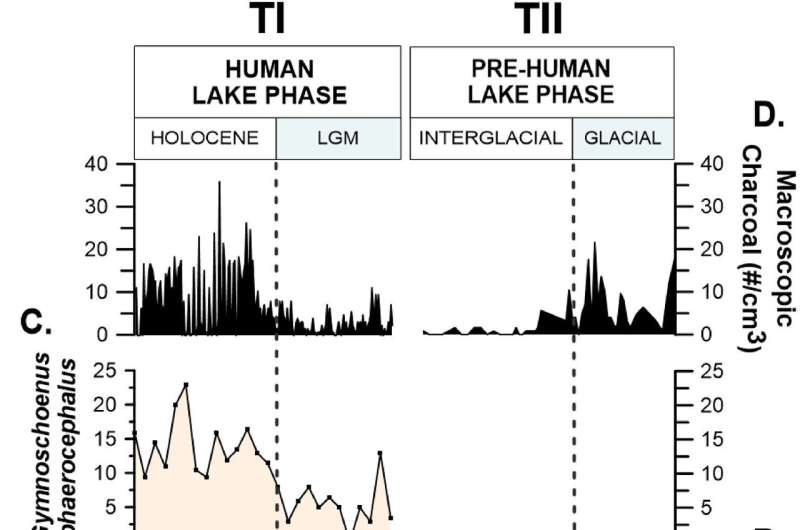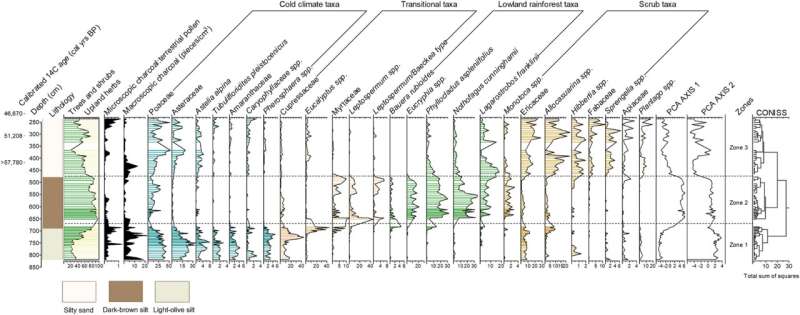March 25, 2024 feature
This article has been reviewed according to Science X's editorial process and policies. Editors have highlighted the following attributes while ensuring the content's credibility:
fact-checked
peer-reviewed publication
trusted source
proofread
Rainforest response to deglaciation impacted by Australian Indigenous populations, study finds

Australia's Indigenous populations have played an important role in modifying the continent's landscape over millennia, particularly by using fire to create open spaces for daily activities. This continued until they left the area in approximately 1860 due to British colonization in the preceding decades, beyond which European land management styles and intensive farming practices became a prominent factor.
How the Indigenous Palawa interactions with the environment have affected its response to glacial and interglacial cycles is the focus of new research published in Quaternary Science Reviews.
Highlighting the cool temperate rainforests of Lutruwita (Tasmania), Sarah Cooley, a Ph.D. researcher at the University of Melbourne, Australia, and colleagues investigated vegetation changes across two key deglaciation events within the last ~190,000 years. Termination II (Marine Isotope Stages 6-5e, 191,000–123,000 years ago) and Termination I (11,700 years ago, transition into Holocene) provide reference points prior to and after human occupation of the area respectively.
Indigenous Palawa populations arrived at Lutruwita about 43,000 years ago when the island of Tasmania was still connected to mainland Australia via a land bridge during a period of low sea levels as ocean water was "locked away" in glaciers. At this time, mountain slopes were treeless and experienced an alpine climate.
To test the response of this island to glacial terminations, sediments were obtained from coring two sites within the Tasmanian Wilderness World Heritage Area in 2018—Darwin Crater, a 1.2 km-wide infilled meteorite impact crater on the west of the island, and Lake Selina, a shallow water body derived from glacial activity.
Once processed, these samples were then analyzed to obtain environmental proxy records, which can indicate changing conditions of the past, including fossil pollen, charcoal and environmental magnetics, alongside radiometric dating to age the samples.
The project was a considerable undertaking as a standard 300 pollen grains were counted and identified under a 400x magnification microscope for each of the 83 samples. More than 31,300 pollen grains and spores were identified in total, matched to 135 taxa.

Three distinct zones were identified within the Darwin Crater sediment sequence, the first of which was dominated by glacial pollen types, with cold climate taxa of Asteraceae (daisies) and Poaceae (grasses), as well as Tubulifloridites pleistocenicus being particularly characteristic of this climate state in Australia.
Zone 2 comprises warmer rainforest pollen types, predominantly temperate deciduous beach and conifers, and is typical of interglacial periods. Therefore, the transition between these two zones is believed to correspond to Termination II. Zone 3 represents a further change from open lake to boggy wetland with continued warming.
Accordingly, the research team found that the arrival of Indigenous Palawa populations to Lutruwita had a marked impact on the landscape's response to glacial terminations. During the last interglacial before anthropogenic disturbance, the endemic conifer Phyllocladus aspleniifolius and deciduous beach Nothofagus cunninghamii dominated lowland rainforests, with very little evidence of fire activity.
However, pollen records from lake sediments indicate their presence almost halved, mostly being replaced by buttongrass moorland (Gymnoschoenus sphaerocephalus), during the current interglacial. This perennial sedge is an important indicator species for human habitation of an area.
In addition to this, a notable increase in charcoal during the Holocene indicates increasing intensity of fire, as the buttongrass moorland is highly flammable. Recovery from fire can be short (12–25 years) and long (150–350 years), the former maintains open vegetation while the latter allows rainforest to regrow.
Considering the abundant evidence of fire in a cool climate zone with high rainfall in Tasmania, this attests to Palawa communities actively managing the landscape with fire activities, converting densely forested areas to open grasslands, and encouraging the proliferation of fire-adapted vegetation and biodiversity.
This research is important context for rapid warming events, exiting a glaciation, as we experience exacerbating climate change. In the face of enhanced intensity and frequency of extreme climate events, the way in which both humans impact and are impacted by modifications of the landscape is vital to understanding ecosystem responses.
In particular, increased drought and wildfire events can rapidly alter local ecosystems, which can take many years to recover. The findings also provide significant evidence for the activities of Australia's Indigenous populations and acknowledges their cultural mark on the landscape.
More information: S. Cooley et al, Rainforest response to glacial terminations before and after human arrival in Lutruwita (Tasmania), Quaternary Science Reviews (2024). DOI: 10.1016/j.quascirev.2024.108572
Journal information: Quaternary Science Reviews
© 2024 Science X Network




















